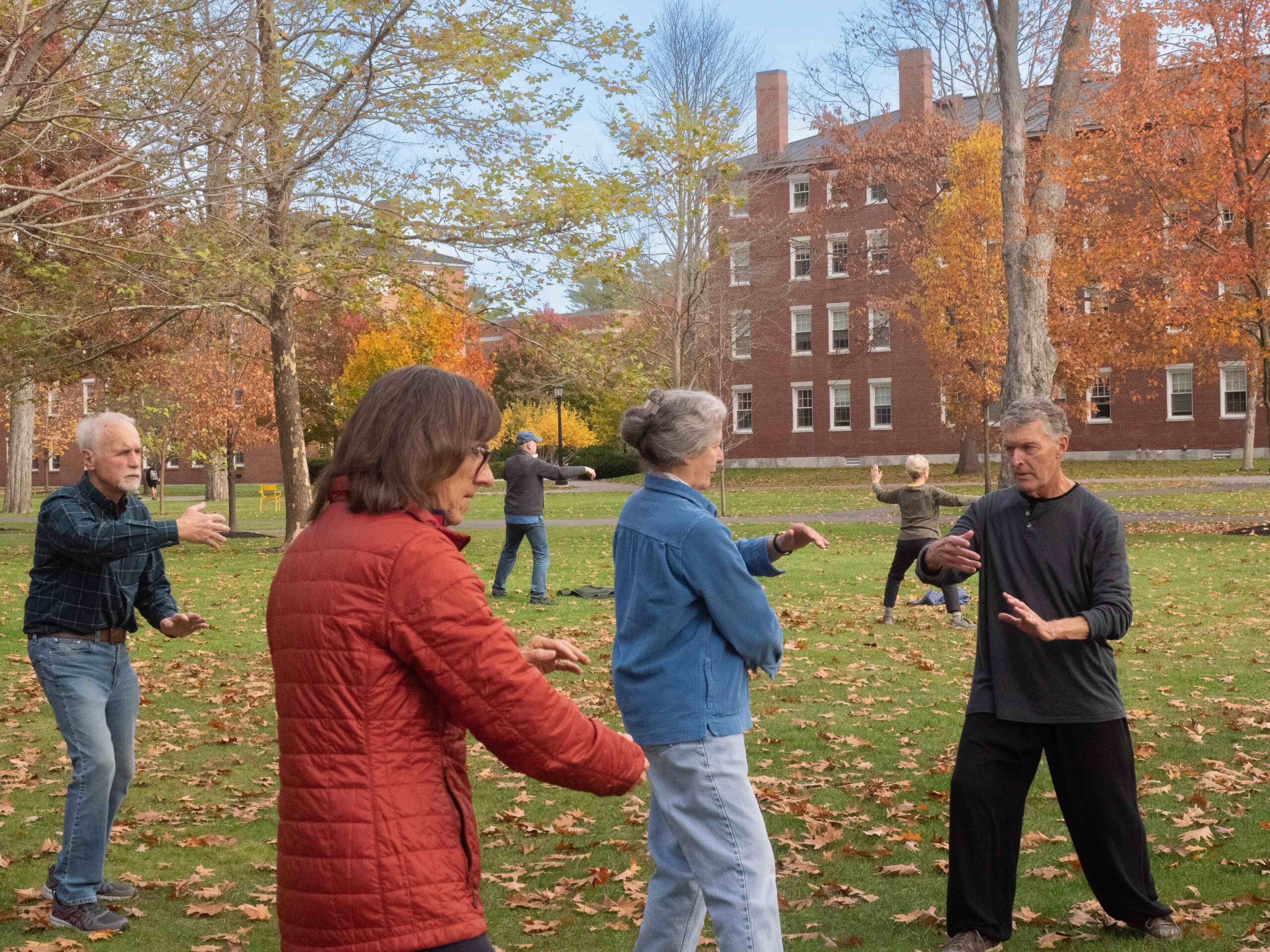Tai Chi brings relaxation techniques to the quad
November 3, 2022
 Alex Spear
Alex SpearEvery Tuesday and Thursday, students hurry across the quad to class, passing by a comparatively less stressful scene—a group of community members practicing Tai Chi.
The classes are taught by Bowdoin alumnus Ken Ryan ’71. Ryan started these classes 20 years ago, and since then they have grown every year.
After initially holding the classes inside academic buildings and College Houses, the classes were moved to the Peter Buck Center for Health and Fitness once it was built. But with the onset of Covid-19, Ryan decided to move Tai Chi classes to the quad.
“Practicing Tai Chi in nature is healing and helpful, especially since Tai Chi and Qigong is about getting a more powerful connection with nature,” Ryan said. “Even so, inside is actually easier to teach people because you don’t have distractions. So there’s a trade off.”
Tai Chi is a moving form of meditation that has been handed down over generations. Ryan defines this meditative movement as a type of martial arts practice that holistically approaches the mental, physical and spiritual health aspects of life. The term translates to the Grand Ultimate.
“Your mind, body and spirit are all connected. They’re part of a whole,” Ryan said. “Generally speaking, a lot of people believe that the more you practice, the more spiritual you become, but not spiritual in relation to churches or ministries or deities—it’s a different deal.”
Professor of Economics Emeritus John Fitzgerald participates in the Tai Chi classes—something he has been practicing for seven years. He initially joined after reading about the practice in the news.
“Tai Chi is somewhat meditative. It’s moving meditation, which is easier for me than sitting meditation, although I try to do both,” Fitzgerald said. “I used to play squash regularly and would often get little injuries. But once I started doing Tai Chi, I had very few of those joint injuries.”
Other than the meditative aspect of Tai Chi, Fitzgerald also enjoys the social aspect of meeting with the class and being around people.
“Part of the fun is just the group of people that you associate with,” Fitzgerald said.
Retired nurse Stephanie Holmes attended the first Tai Chi class that Ryan ever taught, and she decided to stick with the practice for 20 years. Holmes initially started practicing Tai Chi after she had a cerebral aneurysm 30 years ago.
“[The injury] left me with very limited vision and I was dizzy a lot, so I decided to do Tai Chi because I read a New York Times article saying it was helpful for balance,” Holmes said.
Holmes underestimated the physical strain of Tai Chi during her first class, but she continuously learns more about Tai Chi through class every week and finds the necessary endurance gratifying.
“I still remember after 20 years of studying with Ken, the first time he showed us Tai Chi. He was hardly moving at all, but he was sweating buckets,” Holmes said. “And I remember just sitting there going, ‘why is he sweating so much? He’s not even doing anything.’ Now I get it. It’s hard work. It’s challenging. But it’s just absolutely rewarding and fun.”
With 20 years of experience under her belt, Holmes was given the opportunity to lead Qigong classes. Qigong, a subgroup of Tai Chi, is a system of slow, coordinated body movement exercises. According to Holmes, it is considered one of the fundamental basics of wellness in Chinese medicine.
“Qigong is learning to identify your internal chi or energy and learning how to circulate it to promote wellness and well being,” Holmes said. “It’s very powerful. You’re actually marshaling your energy to combat an opponent and learning a form that teaches you different martial applications.”
Holmes especially loves learning Tai Chi on the Quad because she can interact with students.
“I’m old, and I love being at Bowdoin and having students join us over the years,” Holmes said. “We had a baseball pitcher right before the pandemic, and there are moves in Tai Chi that are like throwing on a ball, and it really can inform your ability to pitch. And when I did Qigong on Friday nights, we’d often have students join us, and that was a lot of fun.”
Tai Chi might appeal to Bowdoin students as a fun form of exercise and stress management.
“You’ve got your classes, your social life, your family, your physical health and emotional health. Everything is coming at you from all directions, but Tai Chi is just a time to spend by yourself, trying to slow down, relax and breathe,” Holmes said. “It doesn’t look like it, but it’s really strenuous and very good exercise. It teaches you balance, but it also provides balance in your life.”

Comments
Before submitting a comment, please review our comment policy. Some key points from the policy: